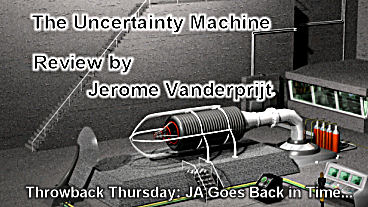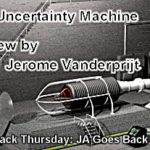
Throwback Thursday – The Uncertainty Machine
Overall, The Uncertainty Machine is a very pleasant game. If you enjoy adventure games and are into trying something different, then you certainly will enjoy this game.




Note: This review was originally published August 7, 2003
First of all, everyone who has given his/her effort to create games for us adventure gamers in his/her spare time without profit deserves a big round of applause. Eduardo Campos – aka Ratracer – is such a person; an independent developer of adventure games using the AGS engine. His first game – The Uncertainty Machine – is free for download. If you are curious about the development of the game, also read my interview with the developer on JA+.
The story is about a newspaper reporter called Susan Gant. Following the introduction, as Susan is on her way to her job as a newspaper reporter, she witnesses a robbery in front of the newspaper building; the first sign that something big is going to happen. Her editor then assigns her a story that will soon involve a mysterious conspiracy. She will, of course, have to investigate the facts using all possible means.
Like most independently developed games the plot is the most important component. Some people may feel the story is unoriginal, but I don’t agree. I think the game is recognizable because the developer was inspired by several popular games. This resulted in a collection of several familiar story aspects combining to form a unique mystery dealing with good and evil.
According to the developer’s website The Uncertainty Machine contains about 90 rooms, 40 dialogs, and 80 inventory items. Well, as I didn’t count them, those figures might be true. But I must say I would expect a much higher amount of dialogs because the story is mainly told using text. Unfortunately, this also resulted in apparently endless conversations between characters during at least two points in the game. Nevertheless, the story is far from boring.
The Uncertainty Machine is a third person point-and-click game. The developer must have played quite a number of adventure games as all of the typical elements you can imagine for an adventure game are included: a city-map, inventory items that can be combined, pixel hunting, a laptop screen, a mobile telephone, multiple endings and more. Eduardo did make clever use of such elements and, to be honest, even of some today’s prominent professional developers still use such elements to ensure their success.
The screen is divided into several parts. At the top you see the playing time and information that Susan has added in her notebook or laptop. Below this is the Inventory bar where you can either combine objects or use them on the playing screen. The playing screen is where the game actually takes place. During dialogs possible lines with questions are listed at the bottom. The interface of the game is simple; left click to interact, talk to other characters or use objects and right click to investigate. Some of the inventory items can be used in close-up views such as the mobile phone and the laptop computer.
Playing the game is not very difficult. Some puzzles are challenging, but none of them is really unsolvable. There is a walkthrough available, but to be honest you should not need it. If you get stuck you probably have missed a clue or conversation somewhere.
The Uncertainty Machine was developed with the freeware AGS (Adventure Game Studio) engine. The AGS engine is based on technology used by Sierra and LucasArts in the early nineties (you surely remember the Kings Quest games). Screen resolution is 640×480 and may result in some coarse graphics on larger monitors. Concerning this, the characters are still well defined. While I thought the Susan’s pink outfit on day one was a bit boring, I was pleasantly surprised by her attire on day two.
The strength of the graphics is the backgrounds, especially some of the furniture. The quality of the backgrounds even seems to improve as the game progresses as though the developer improved his graphic skills during development. Unfortunately the animations are very simple. Sometimes the movements of characters are so unnatural it tends to devaluate the complete picture.
Sounds… what can I tell about sounds? Okay the game has sound effects. They are fine, like the sound of traffic in the street, the elevator bell, breaking glass and birds in the park. The game has no speech and dialogs are written only. You quickly get used to this though, especially if you’ve played the older games. But, in my opinion, the weakest part of this game is the music. It would be a hit in the elevator scene but apart from that it is not too my taste.
I was pleased too see the developer mention on his website his intentions to release a second version with a new score. But if you have read the interview you know this is probably not going to happen. Too bad, cause it really could use some different tracks. In fact, even no music might be an improvement but the game does not feature this option. For this reason, I renamed the file MUSIC.VOX to something different and surprisingly it worked. Be careful though if you do this as I am not sure if the game will remain stable while playing. But, you might want to be fair and listen to the music first, it might be to your individual liking.
Overall, The Uncertainty Machine is a very pleasant game. If you enjoy adventure games and are into trying something different, then you certainly will enjoy this game. Besides, what do you have to lose, the game is free of charge and you just have to take the time to download the 20Mb installation file.
I think Eduardo did a great job and would like to thank him for expending his time and energy in creatingThe Uncertainty Machine. I hope he is encouraged to continue creating adventure games and hope we will hear from him again in the near future.
Final Grade: C+
System Requirements:
System requirements for AGS engine:
- Windows 95, 98, ME, 2000 or XP (NOTE: under Windows XP you may have to use the compatibility feature).
- Pentium 100 MHz or faster system
- At least 32 Mb RAM.
- Mouse and keyboard,
- DirectX compatible sound card
Copyright © 2003 Jerome for http://dev.justadventure.com/, all rights reserved.

Leave a Reply